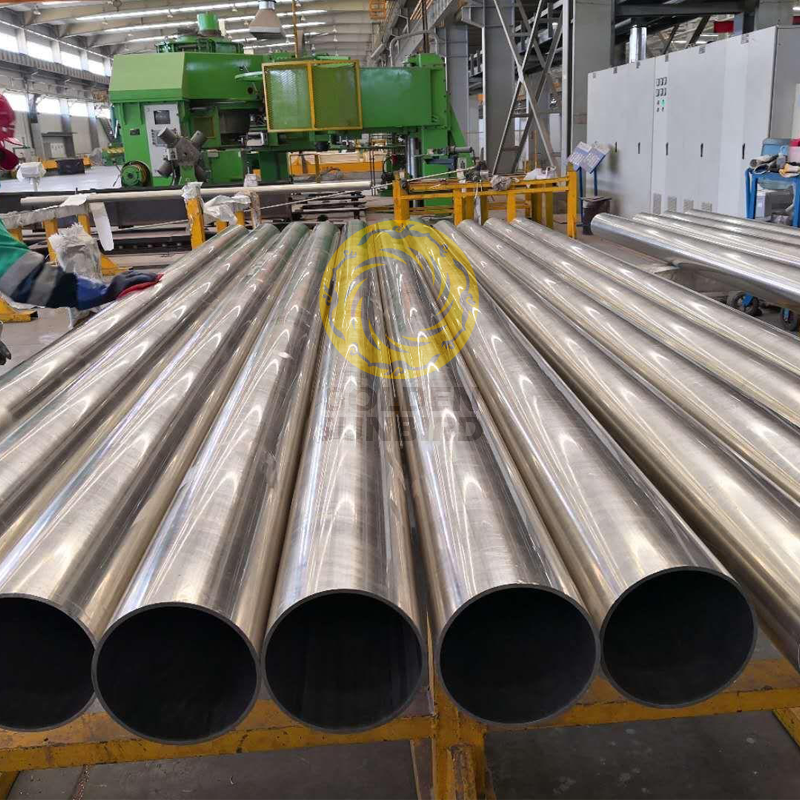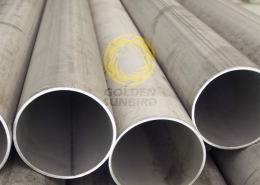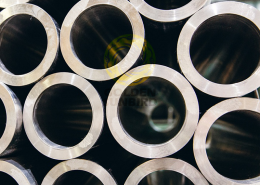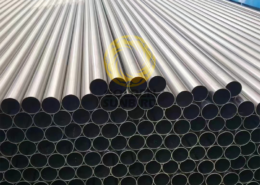ASTM B608 Welded Copper Alloy Pipe
Grade: UNS C61300, C61400, C70620, C71520
Outside Diameter (OD) : 114.3-1219mm
Wall Thickness (WT) :2.38-20.6mm
Length: 3000 – 12000mm
Features
ASTM B608 Welded Copper Alloy Pipe
Welded Copper Alloy Pipe Chemical Composition (wt.%)
| Alloy | (Cu) | (Ni)+(Co) | (Al) | (Pb) max | (Fe) | (Zn) max | (Mn) max | (S) max | (P) max | (C) max | (Sn) | (Si) |
| C61300 | Remainder | 0.15 max | 6.0–7.5 | 0.01 | 2.0–3.0 | 0.1 | 0.2 | – | 0.015 | – | 0.20–0.50 | 0.1 |
| C61400 | Remainder | – | 6.0–8.0 | 0.01 | 1.5–3.5 | 0.2 | 1 | – | 0.015 | – | – | – |
| C70620 | 86.5% min | 9.0–11.0 | – | 0.02 | 1.0–1.8 | 0.5 | 1 | 0.02 | 0.02 | 0.05 | – | – |
| C71520 | 65.0% min | 29.0–33.0 | – | 0.02 | 0.40–1.0 | 0.5 | 1 | 0.02 | 0.02 | 0.05 | – | – |
Welded Copper Alloy Pipe Mechanical Properties (Transverse Tensile Strength, min ksi [MPa])
| Alloy | Tensile Strength |
| C61300 | 70 [485] |
| C61400 | 70 [485] |
| C70620 | 40 [275] |
| C71520 | 50 [345] |
Technical Specifications
| Specification | Value |
| Standard | ASTM B608 Welded Copper Alloy Pipe |
| Grade | UNS C61300 (CuAl7Fe2Sn), UNS C61400 (CuAl7Fe2, EN CW303G), UNS C70620(CuNi10Fe1Mn, EN CW352H), UNS C71520 (CuNi30Fe1Mn, CW354H) |
| Manufacturing Process | Arc-welded |
| Seam Type | Welded |
| Pipe Size | Outside Diameter (OD) Range: NPS 4″ -48″ (114.3-1219.2mm), Wall Thickness (WT) Range: 2.38-20.6mm |
| Length | 6000-12000mm |
| Delivery Condition | Annealed |
| Inspection Certificate | EN 10204 Type 3.1 (Mill Test Certificate), EN 10204 Type 3.2 (Witness Testing or 3rd Party Inspection) |
| Tests | Chemical analysis ASTM E76, E255, E478; Tensile Test ASTM E8; Transverse Guided-Bend Test ASTM E190, Hydrostatic Test, RT |
Packing
Both ends are plain or beveled to an angle of 30°+5°/0° as per ANSI B16.25 and equipped with plastic pipe caps or bevel protectors. Small-diameter pipes are packaged in wooden crates, and large-diameter pipes are wrapped in woven bags.
Application
Shipbuilding and Repair: Used for piping systems on ships and submarines where resistance to seawater corrosion is crucial.
Offshore Platforms: Piping systems for oil and gas extraction platforms exposed to marine environments.
Seawater Intake and Discharge Pipes: Transporting seawater to and from desalination plants, where materials must withstand aggressive, saline environments.
Cooling Systems: Piping for the transport of seawater used in cooling processes for power generation facilities located near the coast.
Piping Systems: In chemical plants, these pipes transport brine or other corrosive chemicals, benefiting from the copper alloy’s corrosion resistance.
Seawater Firefighting Systems: Piping for firefighting systems that use seawater, especially in scarce freshwater areas.
Water Treatment Facilities: Pipes for facilities treating brackish or seawater before it’s released into the environment or used for irrigation or agriculture.
Seawater Circulation Systems: These systems ensure that aquaculture farms that use seawater to rear fish and other marine life do not corrode and contaminate the water.
Industrial Cooling Systems: These are used to construct heat exchangers and condensers that use seawater to cool industrial processes.








